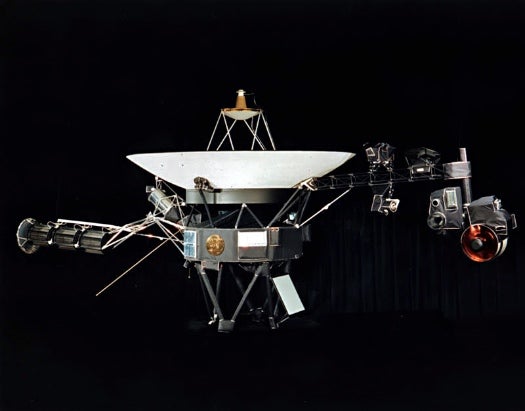Is Voyager 1 Finally Out Of The Solar System? Not Quite
It certainly is in strange new territory, though.

Sailing through a frozen, frothy sea of charged particles, the 35-year-old Voyager 1 spacecraft is so far from its home that our star looks like just another pinpoint of light in the spangled heavens. But the sun is not quite done exerting its influence over our distant emissary. That day may come soon, however.
Whether Voyager is gone or not–which has been a point of debate for a couple of years now–is a momentous question. It will be the first thing humanity has ever sent outside the little neighborhood carved out by our star, making its departure a profound occasion. But scientists are still trying to figure out what departure really means. Now it apparently depends on which scientist you ask.
This afternoon, scientists shared a forthcoming paper explaining some of the weird electromagnetic phenomena the Voyager 1 probe is experiencing in its current location, roughly 11 billion miles from the sun. On Aug. 25 of last year, the spacecraft measured drastic changes in radiation surrounding itself, as cosmic rays from our heliosphere–sort of like a bubble the sun blows around itself–dropped precipitously. At the same time, Voyager saw a huge spike in galactic cosmic rays.
All this weird data could mean that Voyager has exited the heliosphere, according to Bill Webber, professor emeritus of astronomy at New Mexico State University. The probe may now be sampling–for the first time–the interstellar medium. Webber calls it the “heliocliff.”
But Ed Stone, project manager for the twin Voyager probes since their launch, is not so sure. According to him, the science team agrees that it has not hit interstellar space yet–just a bizarre new region called a “magnetic highway,” where radiation acts in mysterious ways.
“A change in the direction of the magnetic field is the last critical indicator of reaching interstellar space and that change of direction has not yet been observed,” he said in a statement.
The co-author on this new paper, F.B. McDonald of the University of Maryland, died just a week after those Aug. 25 anomalies. Meanwhile, the paper McDonald wrote with Webber has been accepted for publication in the journal of the American Geophysical Union.